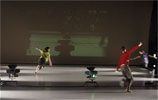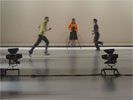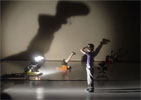I belong to your image. Sequence of panoramas
2005
performance, panoramas, video, dance,perception, memory, laboratory
pere faura
aimar perez / nina fajdiga
aitana cordero
guillem mont
pere faura
closer music
gabriel smeets
25 minutes
theaterschool, Amsterdam
theatreschool, Amsterdam, november 2004
“I belong to your image. Sequence of panoramas” is the continuation of the work started on february 2004 with “panoramas. video and dance”. The reserach is based on the realtion between life body and projected body, exploring the posible combinations of dance in camera and questioning the conventions of theatre and cinema by putting them together.
Light-dance-video change space, change perception, change attention.
We show the audience the trick, the motor, the mechanics of the theatrical convention. There are no curtains, no hidden lights, no backstage. There’s only one space, the same for the performers/technicians and the audience. There’s nothing beyond that. Everything is shown. The space is transformed into an audio-visual laboratory, where the performers construct and become the images at the same time. The traditional black magic box is transformed into a white laboratory for machines and human bodies to interact with each other and dislocate constantly time and space, in a very organized orgy where audience witnesses like a voyeur.
I change you. You change me.
By giving the audience the possibility to look at our bodies in movement trough many different angles of space and time, we try to seduce them by making them confuse about their own perception. We want to stimulate the wonder, the doubt about the perception. That’s why everything else needs to be clearly shown, the machine needs to be discovered, the tools need to be naked, so the wonder about the perception lies within the subjects-audience, and not in relation to the objects-performers.
Doubting creates attention, confusing creates illusion.
| date | venue |
| 2004.November |
theaterschool, Amsterdam |
2004.June |
ITS Festival, Amsterdam |
| 2005.September | Uit Markt Festival, Amsterdam |
The lights:
-
3 PCs on the floor
with floor stands
- 5 columns of white side lights
- White horizon lights illuminating the back wall
- 8 profiles to separate the stage in two rectangles
- Audience light
- A 24 channel light table controllable from the stage
The video equipment:
- 1 digital camera
- 1 tripod
- 1 beamer
The sound:
- 1 minidisc or cd palyer
- 1 microphone wireless
- 1 mixer table with two channels
The space:
- The space needs to be completely discovered, with no curtains
- White back wall
- White floor
Note:
All the machines are controlled by the performers. So the sound system,
the light system and all the video equipment need to be on stage.






